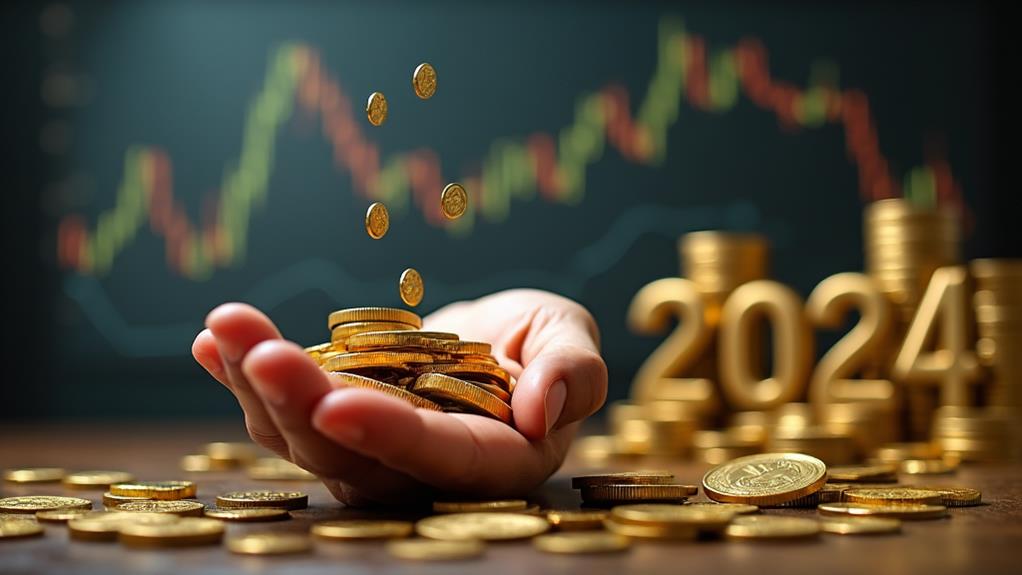As the global economic landscape continues to evolve, investors are increasingly turning to precious metals as a safeguard against uncertainty. Peter Schiff, a renowned economist and gold advocate, offers seven vital tips for those contemplating gold investments in 2024. These insights provide a roadmap for navigating the complex world of precious metals, addressing fundamental aspects such as diversification, physical ownership, and market timing. While Schiff's advice has attracted attention, it's important to examine each recommendation carefully and reflect on how they align with individual investment goals and risk tolerance. The question remains: Are these strategies truly the cornerstone to unlocking gold's potential in the coming year?
Key Insights
- Focus on physical gold ownership to protect against economic uncertainty and inflation.
- Diversify within precious metals, including gold, silver, platinum, and palladium.
- Adopt a long-term investment strategy, understanding that gold's value appreciates over time.
- Monitor global economic indicators and central bank policies to make informed investment decisions.
- Beware of paper gold and counterparty risks; prioritize taking physical possession of gold.
Understand Gold's Intrinsic Value

Investors seeking to enter the gold market must first understand the concept of gold's vital value. Gold bullion has long been regarded as an inflation hedge and a safeguard against economic recession.
As a precious metals investment, gold's fundamental worth stems from its ability to maintain purchasing power during times of currency devaluation. Unlike fiat currencies, gold's value is not subject to government manipulation or printing.
Peter Schiff, CEO of SchiffGold, emphasizes, "Gold and silver are real money, offering protection against the erosion of wealth caused by inflation."
When evaluating gold investment, it's imperative to:
- Research physical gold storage options
- Diversify portfolio with both gold and silver
- Seek professional investment advice
Understanding gold's fundamental value helps investors make informed decisions, particularly during economic uncertainties.
As a tangible asset, gold provides a sense of security and stability in volatile financial markets.
Diversify Within Precious Metals
Frequently overlooked by novice gold investors, diversification within the precious metals sector is critical for building a strong portfolio. A well-balanced precious metals investment strategy can help protect against market volatility and inflation.
Consider the following diversification options:
- Gold coins and bars for stability
- Silver for potential growth and industrial demand
- Platinum for its rarity and industrial applications
- Palladium for its unique properties and limited supply
While gold remains a cornerstone of precious metals investing, incorporating other metals can improve your portfolio's resilience.
Silver, for example, often outperforms gold during periods of economic growth. Platinum and palladium offer exposure to different market dynamics.
Consider Physical Gold Ownership

Exploring physical gold ownership offers a tangible approach to precious metals investing. Investors can acquire gold bullion in various forms, including coins and bars, through reputable precious metals dealers.
When contemplating a gold investment, it's essential to understand current gold market trends and gold price forecasts.
Physical gold ownership provides several advantages:
- Direct control over assets
- Protection against economic uncertainty
- Potential hedge against inflation
However, investors should be aware of storage and security factors. A gold IRA can offer tax advantages for retirement planning, but requires careful setup and management.
Before investing, research gold supply and demand factors to make informed decisions. Think about diversifying with both gold and silver bullion to spread risk.
Monitor Global Economic Indicators
Economic barometers play a vital role in gold investment decisions. Peter Schiff, a renowned financial analyst, emphasizes the importance of monitoring global economic indicators when evaluating gold investments.
To make informed decisions in volatile markets, investors should focus on:
- Central bank policies and monetary policy shifts
- Global economic outlook and growth projections
- Inflation rates and currency fluctuations
- Geopolitical tensions and their impact on financial markets
These factors significantly influence gold market trends and price forecasts for 2024.
As the global economy continues to evolve, staying informed about economic indicators becomes imperative for navigating the gold market. Investors should regularly analyze financial data, track central bank decisions, and assess the overall economic landscape.
By doing so, they can better anticipate potential shifts in gold prices and make strategic investment choices.
Timing Your Gold Purchases

Timing gold purchases requires a sharp understanding of market cycles, as gold prices often move inversely to economic conditions.
Investors should consider the strength of the U.S. dollar, as a weaker dollar typically correlates with higher gold prices.
Monitoring crucial economic indicators, such as inflation rates and geopolitical tensions, can provide valuable insights for determining optimal entry points in the gold market.
Market Cycle Awareness
In the field of gold investment, market cycle awareness plays a crucial role in optimizing returns. Understanding the cyclical nature of financial markets, including stocks, currencies, and commodities, can help investors make informed decisions about when to invest in gold.
Market cycles often correlate with economic indicators, interest rates, and overall financial volatility.
To improve market cycle awareness for gold investment:
- Study historical gold price trends in relation to economic recessions
- Monitor global currency fluctuations and their impact on gold prices
- Analyze the relationship between interest rates and gold performance
- Track stock market volatility as a potential indicator for gold demand
Dollar Strength Consideration
Understanding the relationship between the strength of the U.S. dollar and gold prices is essential when pondering the timing of gold purchases.
Peter Schiff's gold investment tips for 2024 emphasize the importance of monitoring the dollar's status as a reserve currency. As the Federal Reserve's monetary policies affect dollar strength, investors should consider how this impacts gold's value. When the dollar weakens against other currencies like the euro, gold often becomes more attractive to investors.
Central banks' actions and economic forecasts play a significant role in determining dollar strength. Schiff suggests that the dollar may be overvalued, potentially leading to a decline in its value. This could create opportunities for gold investors.
Nevertheless, timing the market precisely is challenging. Investors should:
- Stay informed about global economic trends
- Monitor Federal Reserve policies
- Consider dollar strength in relation to other currencies
- Assess gold's potential as a hedge against dollar weakness
Economic Indicator Monitoring
Consistently monitoring crucial economic indicators is vital for investors aiming to optimize their gold purchase timing. Schiff believes that understanding these indicators can help predict market trends and steer through the uncertain world of gold investment.
To gain insight into economic conditions affecting gold prices, investors should:
- Track inflation rates and Consumer Price Index (CPI) data
- Monitor central bank policies and interest rate decisions
- Analyze geopolitical events and their impact on global markets
- Observe currency fluctuations, particularly the strength of the US dollar
Beware of Paper Gold
When contemplating gold investments, it's essential to understand the difference between physical gold and paper gold, such as exchange-traded funds (ETFs).
While ETFs offer convenience and liquidity, they come with unique risks, including potential counterparty default.
Investors should carefully weigh these factors, recognizing that physical gold ownership provides direct control over the asset, whereas paper gold relies on third-party management and financial stability.
Physical Vs. ETF Risks
Investors considering gold as a portfolio addition must carefully weigh the risks associated with physical gold ownership against those of gold-backed exchange-traded funds (ETFs).
While physical gold offers tangible security, it requires secure storage and insurance. Gold ETFs, on the other hand, provide easier trading and lower storage costs but expose investors to counterparty risks.
Consider these factors when choosing between physical gold and ETFs:
- Liquidity: ETFs offer greater ease of buying and selling
- Storage: Physical gold requires secure storage, while ETFs eliminate this concern
- Costs: ETFs may have lower overall fees compared to storing physical gold
- Ownership: Physical gold provides direct ownership, while ETFs represent a claim on gold
Consult a reputable precious metals dealer or broker before investing in gold.
Whether opting for bullion or a gold IRA, understand that gold prices can fluctuate, affecting the value per ounce of your investment.
Counterparty Default Concerns
Three critical counterparty default risks loom over investors who choose "paper gold" instruments like ETFs or futures contracts.
First, the risk of financial institution collapse, reminiscent of the 2008 financial crisis, could leave investors empty-handed.
Second, gold mining stocks may face operational challenges or bankruptcy, eroding value.
Third, ETF custodians might not hold sufficient physical gold to back their shares.
To mitigate these risks, experts recommend working with a reputable precious metals dealer specializing in physical gold.
Peter Schiff advises, "Seek a dealer with integrity and experience, offering competitive prices and dependable service."
He emphasizes the importance of taking physical possession of gold to eliminate counterparty risk.
For those looking to retire securely, exploring with physical gold can provide a hedge against economic uncertainty and protect wealth from potential financial system failures.
Long-Term Investment Mindset

For successful gold investment, adopting a long-term mindset is vital. In 2024, investors should focus on steady, long-term strategies for their savings. Gold and other precious metals offer a stable platform for investing, with companies like Euro Pacific and SchiffGold's providing personal service to assist investors.
When contemplating long-term gold investment, keep these points in mind:
- Patience is crucial; gold's value appreciates over time
- Diversify your portfolio to include physical gold and mining stocks
- Stay informed about global economic trends affecting gold prices
- Regularly review and adjust your investment strategy
My Final Thoughts
Peter Schiff's gold investment tips for 2024 offer a cautious approach to navigating uncertain economic waters. While gold glitters alluringly, investors must tread carefully, balancing diversification with physical ownership. The sage advice to monitor global indicators and time purchases wisely echoes through the ages, yet the warning against paper gold rings particularly true in an era of financial sorcery. As markets fluctuate, Schiff's guidance serves as a golden compass for those seeking stability in tumultuous times.







